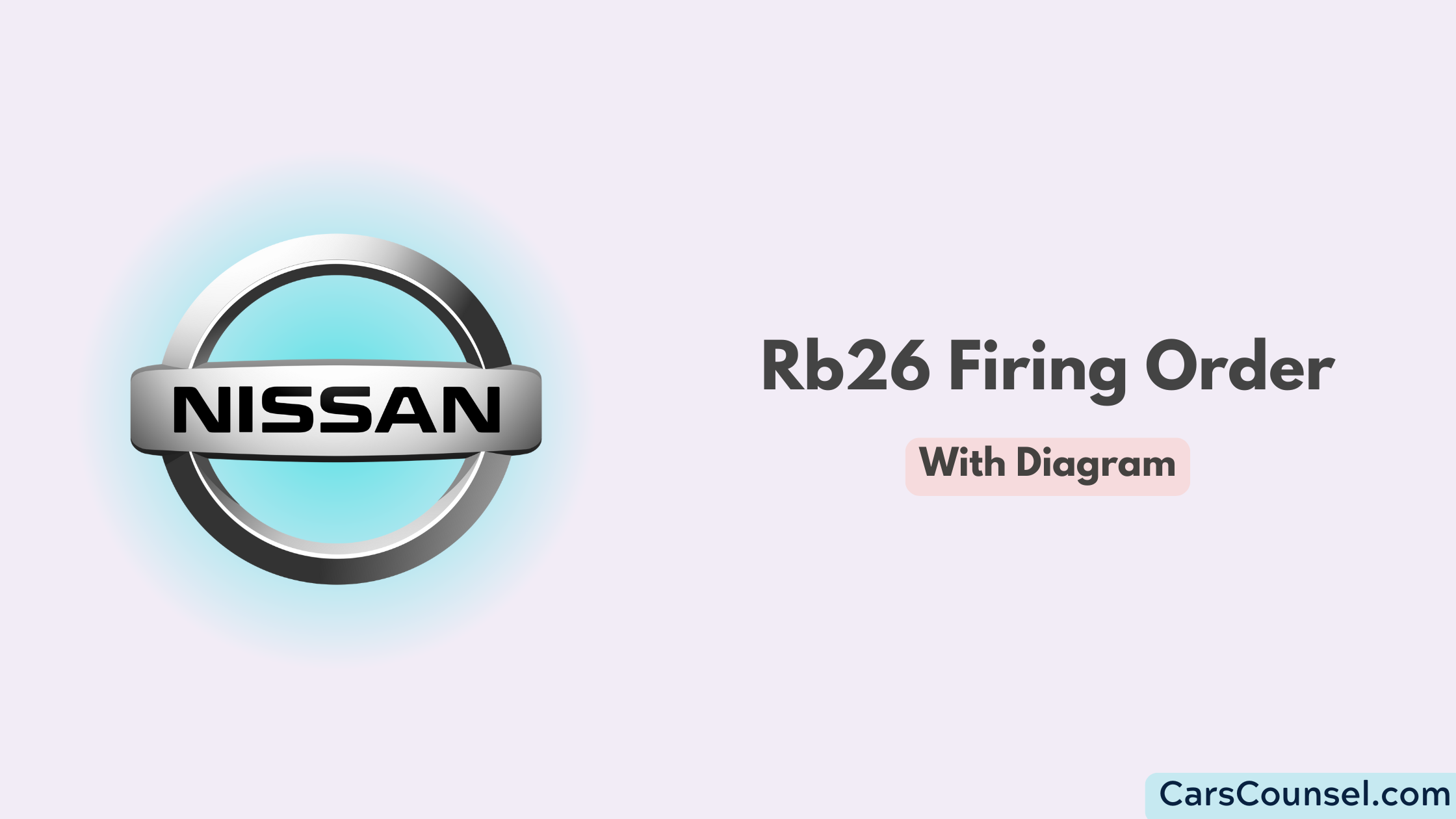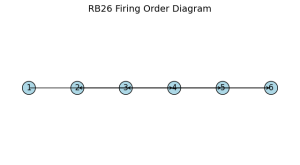The Nissan RB26 engine, famously associated with the Skyline GT-R, is one of the most celebrated straight-six engines in automotive history. Its power, reliability, and tuning potential have made it a favorite among enthusiasts and performance tuners worldwide.
At the heart of this legendary engine lies the firing order—the sequence in which its cylinders ignite their air-fuel mixture. Understanding the RB26 firing order is essential for maintaining smooth operation, optimal performance, and long-term reliability.
This guide explains everything you need to know about the RB26 firing order in an easy-to-understand, conversational format.

Quick Navigation
What is the Firing Order?
In the RB26DETT engine, the firing order is 1-5-3-6-2-4.

The firing order of an engine is the sequence in which its cylinders ignite their air-fuel mixture during operation. This sequence is carefully designed to balance power delivery, reduce vibrations, and ensure efficient combustion.
Why is the Firing Order Important?
The firing order directly affects the engine’s performance and durability. Here’s why it’s crucial:
Smooth Operation
The firing order balances power strokes across the crankshaft, minimizing vibrations and delivering the signature smoothness of straight-six engines.
Efficient Power Delivery
A properly executed firing order ensures consistent and balanced power output, critical for high-performance applications like those of the RB26.
Optimized Combustion
The sequence ensures each cylinder fires at the right time, maximizing combustion efficiency and power generation.
Reduced Wear and Tear
A correct firing order minimizes stress on engine components, extending the lifespan of the crankshaft, bearings, and other internal parts.
Prevention of Misfires
The firing order eliminates irregularities in the combustion process, preventing misfires and associated performance issues.
Understanding the RB26 Engine Layout
The RB26DETT is an inline-six engine, which means all six cylinders are arranged in a single straight line. This layout is inherently balanced, making it ideal for smooth and consistent power delivery.
Cylinder Numbering
In the RB26 engine:
- Cylinder 1: Located at the front of the engine, closest to the timing belt or accessory drive.
- Cylinder 6: Located at the rear of the engine, near the flywheel.
The cylinders are numbered sequentially from front to back. Understanding this layout is key to decoding and applying the firing order.
The Firing Order: 1-5-3-6-2-4
The 1-5-3-6-2-4 firing order is a standard configuration for inline-six engines. Here’s how it works in the RB26:
- Cylinder 1 Fires First: At the front of the engine, cylinder 1 begins the ignition cycle.
- Cylinder 5 Fires Next: The sequence moves to cylinder 5, located near the rear of the engine.
- Cylinder 3 Fires Third: The ignition progresses to cylinder 3, in the middle of the engine.
- Cylinder 6 Fires Fourth: Cylinder 6, at the rear of the engine, fires next.
- Cylinder 2 Fires Fifth: The sequence returns to the front with cylinder 2.
- Cylinder 4 Fires Last: Finally, cylinder 4 completes the cycle before it repeats.
This alternating pattern distributes power strokes evenly across the crankshaft, ensuring smooth operation and balanced power delivery.
Components Involved in the Firing Order
Several critical components work together to execute the firing order in the RB26 engine:
Crankshaft
The crankshaft converts the pistons’ up-and-down motion into rotational energy, synchronized with the firing sequence.
Camshafts
The camshafts control the timing of the intake and exhaust valves, ensuring they open and close in sync with the firing order.
Ignition System
The ignition system, which includes the ignition coil packs and spark plugs, delivers electrical energy to ignite the air-fuel mixture in the correct firing sequence.
Engine Control Unit (ECU)
The ECU manages ignition timing and fuel injection, ensuring precise synchronization with the firing order.
Turbochargers
While not directly part of the firing order, the RB26DETT’s twin turbos rely on the exhaust pulses generated by the firing sequence to maintain consistent boost pressure.
Symptoms of Firing Order Issues
If the firing order is incorrect or disrupted, the RB26 engine will exhibit clear symptoms. Identifying these early can help prevent severe damage:
Engine Misfires
An incorrect firing sequence causes irregular combustion, resulting in misfires and reduced performance.
Rough Idling
The engine may vibrate excessively or stall at idle if the firing order is out of sync.
Loss of Power
A disrupted firing order reduces the engine’s efficiency, leading to sluggish acceleration and weak overall performance.
Knocking or Backfiring
Incorrect ignition timing may result in premature combustion, causing knocking sounds or backfires.
Increased Fuel Consumption
A misaligned firing sequence forces the engine to work harder, burning more fuel to compensate.
Diagnosing and Correcting Firing Order Issues
If you suspect a problem with the firing order in your RB26 engine, follow these steps to diagnose and resolve it:
Step 1: Inspect the Ignition System
- Check the ignition coil packs and spark plugs for damage or wear.
- Ensure the coil packs are connected to the correct cylinders according to the 1-5-3-6-2-4 firing order.
Step 2: Use a Timing Light
- Attach a timing light to cylinder 1 and observe the timing marks on the crankshaft pulley.
- Adjust the ignition timing as needed to match factory specifications.
Step 3: Test the ECU
- Scan the ECU for error codes that might indicate misfires or ignition timing issues.
- Reset or reprogram the ECU if necessary.
Step 4: Consult the Service Manual
- Refer to the Nissan service manual for detailed diagrams and instructions specific to the RB26 engine.
Step 5: Test the Engine
- Start the engine and monitor its performance. Look for smooth idling, consistent power, and reduced vibrations.
Maintenance Tips for Preserving the Firing Order
Proper maintenance ensures the firing order remains intact and the engine performs optimally. Here are some tips:
Replace Spark Plugs Regularly
Worn or fouled spark plugs can disrupt the ignition process. Replace them at recommended intervals.
Inspect Ignition Coils
Check for cracks, corrosion, or loose connections in the ignition coil packs. Replace damaged coils promptly.
Monitor the ECU
Regularly check the ECU for error codes or misfire indications and address any issues immediately.
Verify Engine Timing
Use a timing light periodically to ensure the ignition timing aligns with the firing order.
Clean the Fuel System
Maintain the fuel injectors and lines to support efficient combustion in each cylinder.
Common Misconceptions About Firing Order
“All Inline-Six Engines Have the Same Firing Order”
While 1-5-3-6-2-4 is common, some inline-six engines use different firing orders depending on their design.
“Firing Order Doesn’t Impact Performance”
An incorrect firing order can severely impact performance, leading to misfires and reduced efficiency.
“You Can Change the Firing Order for Better Power”
Altering the firing order without redesigning the engine can cause significant mechanical issues.
Engines with Similar Firing Orders
- 2001 Nissan Altima Firing Order
- 2002 Nissan Altima Firing Order
- 2008 Nissan Titan Firing Order
- 2006 Nissan Titan Firing Order
- 2005 Nissan Titan Firing Order
Conclusion
The firing order of the RB26 engine, 1-5-3-6-2-4, is a fundamental part of its operation and performance. By understanding this sequence and maintaining the components that support it, you can ensure your engine runs smoothly and reliably. Whether you’re performing routine maintenance or troubleshooting an issue, knowledge of the firing order is essential for keeping your RB26 in peak condition.
With proper care and attention, your RB26 engine will continue to deliver the exceptional performance and reliability that have made it a legend in the automotive world. Whether stock or heavily tuned, keeping the firing order intact ensures your engine remains a masterpiece of engineering.

